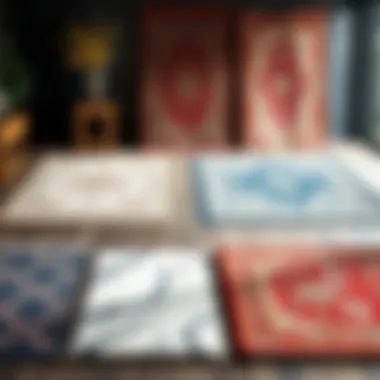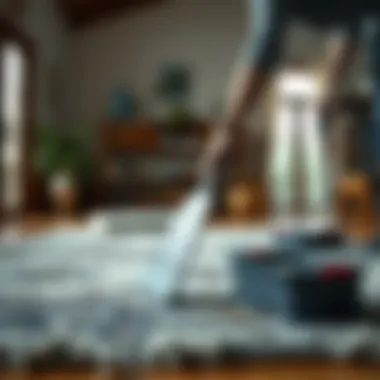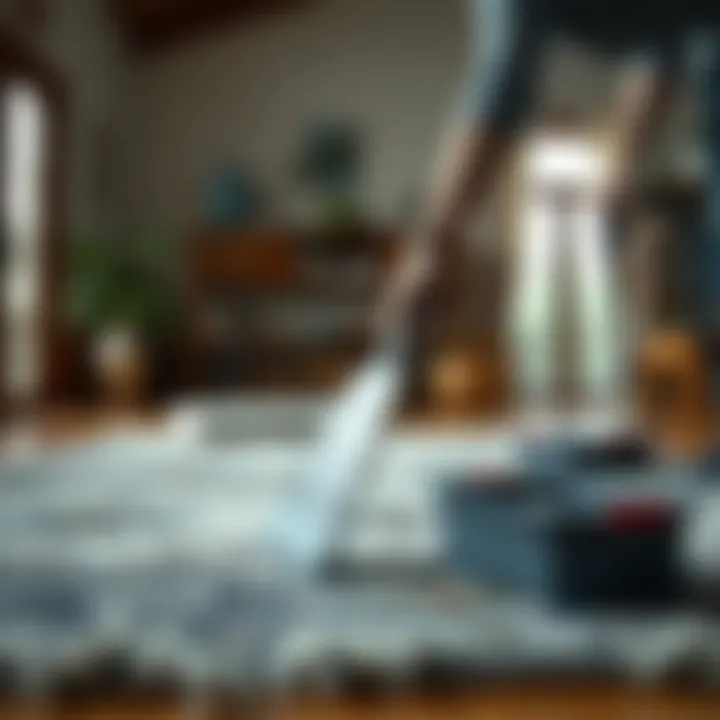Expert Tips for Washing Area Rugs Effectively


Intro
Washing area rugs may seem like an effortless task, but there's more than meets the eye. Rugs serve as central pieces in many homes, bringing warmth and style to the space. Their maintenance is vital, not just for aesthetics, but for extending their lifespan and keeping a clean environment. After all, a dirty rug can harbor dust, allergens, and even unpleasant odors—taking away from the overall appeal of your home.
In this guide, we will dissect the various methods for effectively washing area rugs, highlighting the key aspects that every homeowner needs to keep in mind. From understanding different rug materials to outlining best practices and common pitfalls, this article will ensure that your rugs look their best while providing you with practical solutions to tackle this sometimes daunting chore.
Understanding Your Area Rugs
Before delving into the washing techniques, it’s essential to know the kind of rug you have. Not all rugs are created equal, and each type requires a distinct approach to cleaning. For instance, wool rugs, with their rich textures and natural properties, need a gentler touch. On the other hand, synthetic rugs can often withstand harsher cleaning methods. Recognizing these key differences can prevent irreversible damage and maintain the rug’s original allure.
Common Rug Types:
- Wool Rugs: Known for their durability, warmth, and natural stain resistance.
- Silk Rugs: Luxurious but require special care due to their delicate fibers.
- Synthetic Rugs: Easier to clean and often more resistant to stains, but can lack the depth of natural materials.
Highlighting these differences sets the foundation for understanding how to properly clean rugs based on their composition. This will lead seamlessly into exploring specific cleaning techniques tailored to each type, as well as listing common mistakes to avoid. By following along, you'll be better prepared to keep your rugs in tip-top shape, all while maintaining the comfort and charm they bring to your living space.
Types of Area Rugs
Understanding the different types of area rugs is crucial when it comes to their maintenance and cleaning. Each fabric has distinct properties, and knowing these specifics can help homeowners choose the proper washing techniques and products. Selecting the right rug can also affect its longevity and how it complements a space. In this section, we will explore natural fiber rugs, synthetic fiber rugs, and combination fiber rugs, examining their materials, characteristics, and best care practices.
Natural Fiber Rugs
Natural fiber rugs are made from organic materials and carry unique benefits, appealing to eco-conscious consumers and those who appreciate their aesthetic qualities.
Wool
Wool is a robust and resilient material, making it an excellent choice for rugs that endure high foot traffic. Its natural elasticity means it bounces back after being compressed, ensuring a longer lifespan. An intriguing characteristic of wool is its ability to naturally repel stains due to the lanolin present in the fibers. However, it may require more care in terms of washing, as it can shrink if not treated properly. Thus, while wool rugs are durable and maintain their looks over time, they benefit greatly from thorough yet gentle cleaning methods.
Cotton
Cotton rugs are popular due to their softness and versatility. They can be machine washed, making them a practical choice for families or those with pets. The key characteristic of cotton is its breathability, which allows air circulation and comfort underfoot. However, they do show dirt and stains more readily compared to other materials. Another drawback is their tendency to fade under direct sunlight. Despite these challenges, cotton rugs provide a budget-friendly option for enhancing home decor.
Silk
Silk rugs add an air of luxury and sophistication to any space. They are known for their luster and soft feel, creating an inviting atmosphere. The key aspect of silk is its delicate nature; while they are visually stunning, they require special care. Silk rugs can easily be damaged by water and harsh cleaning agents, making them less ideal for high-traffic areas. For those willing to invest time and resources, silk rugs are breathtaking and can enhance aesthetic appeal.
Synthetic Fiber Rugs
Synthetic fiber rugs have gained popularity due to their durability and variety of designs. They are often more affordable and resistant to stains and fading compared to natural fibers.
Nylon
Nylon is celebrated for its toughness and resilience. This material is resistant to wear and tear, making it suitable for households with pets and children. Key to nylon rugs is their fade resistance, meaning they maintain their colors well, even after exposure to sunlight. However, frequent cleaning with harsh chemicals can still lead to degradation over time. A good balance of proper care can extend the life of a nylon rug significantly.
Polypropylene
Polypropylene rugs are highly regarded for their water and stain resistance. This artificial fiber can withstand spills and dirt, making it a practical choice for busy kitchens or outdoor spaces. The notable feature here is its ease of cleaning—often just a simple wash with mild detergent suffices. However, they can lack the plush feel of their natural counterparts, which could be a drawback for some homeowners seeking a cozy atmosphere.
Acrylic
Acrylic rugs are known for resembling wool but at a lower price point. They are vibrant and can be produced in a variety of colors and patterns. One of the standout aspects of acrylic is its ability to resist moisture and mildew, making them a great option for humid climates. However, when it comes to resilience against heavy foot traffic, they may not hold up as well as nylon or polyester. Eventually, careful consideration of placement will help in avoiding quick wear.
Combination Fiber Rugs
Combination fiber rugs, as the name suggests, blend different materials to create unique textures and properties suitable for various environments.
Hybrids
Hybrid rugs mix natural and synthetic fibers, capitalizing on the benefits of both worlds. This means you can enjoy the softness of wool while gaining the durability of synthetic materials. The versatility of hybrids makes them suitable for different settings, whether it be a cozy living room or a contemporary office space. However, the washing instructions can vary depending on the predominant fiber used, so attention to detail is important during care.
Blends
Blends refer to rugs made from various fibers, such as cotton mixed with nylon. This fusion allows for complexity in appearance and function, while also balancing cost and durability. Blended rugs often offer greater variety in styling, attracting those who want something unique without breaking the bank. Though these pieces can be easier to maintain, understanding the specific care requirements of each fiber still remains essential in preserving their integrity.
Assessing Rug Condition
Before diving into the cleaning process, it is crucial to take a good, hard look at the rug’s condition. Knowing what you're dealing with can significantly impact how you approach washing it. Assessing the condition allows you to target specific problem areas, preserve the integrity of your rug, and ultimately maintain its aesthetic and functional value.
Identifying Stains and Dirt
Types of Stains
Stains come in many shapes and sizes, deriving from various sources—food spills, pet accidents, or even muddy shoes. Understanding the different types of stains is essential for your cleaning strategy. For example, organic stains, like those from coffee or wine, may require specific cleaners that can break them down effectively.
Each stain has its characteristics and cleaning requirements.
- Organic Stains: Made from natural materials, they often need enzyme-based cleaners to digest the organic matter effectively.
- Inorganic Stains: These are from substances like ink or paint and often require chemical solvents.
Not all stains behave the same way; knowing which type you're dealing with can enhance your cleaning success rate. If you misuse the wrong cleaner, it can lead to further damage, icing on the cake of your rug woes.
Level of Soiling


Evaluating the level of soiling takes you a step further. This measure assesses how much dirt and grime have accumulated over time. Light, moderate, and heavy soiling each requires a different approach.
- Lightly Soiled: A quick vacuum and spot clean may suffice.
- Moderately Soiled: You might need to consider a more thorough cleaning method, such as hand washing.
- Heavily Soiled: This level often calls for professional intervention, as DIY methods may not do the trick.
The unique feature of distinguishing soiling levels can save you time and effort. Over-scrubbing a gently soiled rug could lead to unnecessary wear, while not giving enough attention to a heavily soiled one leaves your rug looking shabby.
Evaluating Wear and Tear
Fading
Fading indicates uneven exposure to light, often a result of sunlight streaming in through a window or constant foot traffic. This aspect is important in assessing overall rug health because fading can change the rug’s color dynamics and affect its visual appeal.
- Visual Characteristics: Faded areas might appear lighter, showing a significant difference in color.
- Impact on Cleaning: Understanding which parts have faded informs you on how to handle those areas carefully—harsh scrubbing could worsen the problem.
The delicate nature of faded colors makes it essential to tailor your cleaning routine, ensuring you don’t exacerbate any fading issues.
Fraying
Fraying occurs when fibers begin to unravel, often due to wear and tear from foot traffic, age, or incorrect cleaning methods. Checking for fraying can significantly inform your cleaning process.
- Visible Signs: Look for loose threads or uneven edges.
- Consequences of Neglect: If fraying goes untreated, it could lead to irreversible damage, requiring costly repairs or replacements.
Being attuned to fraying allows you to be proactive—using gentler cleaning techniques or even avoiding certain areas during washing, preserving your rug’s life span.
"A stitch in time saves nine." Recognizing and addressing wear and tarnish promptly can prevent hefty costs later on.
Assessing both stains and general wear equips you with practical knowledge to approach both cleaning and maintenance efficiently. Ignoring these considerations might leave your rug looking worse for wear instead of revitalized.
Pre-Cleaning Steps
Washing area rugs effectively begins long before you get your hands wet. Pre-cleaning steps are essential for ensuring that the washing process is successful and that your rugs come out looking their best. By engaging in appropriate pre-cleaning methods, you can identify the conditions of your rug and prepare it for an optimal cleaning experience.
Vacuuming Techniques
Proper Vacuum Settings
Setting your vacuum for the type of rug you have is crucial. For instance, area rugs made from delicate fibers like silk or wool require a gentler touch. Using a handheld vacuum or a setting designed for carpets minimizes wear. This individualized approach helps maintain the fibers' integrity while effectively removing dirt. On the other hand, thicker substance rugs like wool can take a sturdier setting. Proper vacuum settings ensure that dirt is not ground deeper into the fibers, which is a common pitfall many homeowners face.
Frequency of Vacuuming
The frequency of vacuuming plays a significant role in your rug’s lifespan. In high-traffic areas, you might want to vacuum twice a week, while in less frequented spaces, once every two weeks can suffice. This regular upkeep prevents dirt accumulation and reduces the effort needed for deeper cleanings later on. A common mistake is waiting too long to vacuum. The longer dirt lingers, the harder it is to eliminate those stubborn stains. A smart schedule incorporates vacuuming into your routine, thus protecting your investment.
Spot Cleaning
Choosing the Right Cleaner
Opting for the right cleaner can make a world of difference when it comes to spot cleaning. It’s vital to choose a cleaner that aligns with your rug's material. For instance, natural fiber rugs may benefit from a mild soap solution rather than harsh chemicals that may cause fading or other damage. Many people overlook this detail, leading to regrettable consequences. Effective spot cleaning hinges not just on removing stains, but also ensuring that your cleaning method doesn’t unintentionally harm your rug.
Methodical Application
Applying your cleaner in a methodical fashion allows for maximum effectiveness. Dab the cleaner onto the spot rather than scrubbing vigorously; this helps to lift stains without creating additional damage. A gentle but thorough application also prevents the cleaner from spreading and creating further stains. Ensuring you follow a stepwise approach allows the rug to be cleaned efficiently and becomes second nature with practice.
Important Note: Always test any cleaner on a small, inconspicuous area before the general application. This precaution avoids unwanted mishaps, such as discoloration or fiber damage.
Overall, these pre-cleaning steps lay the groundwork for a successful rug washing experience. By taking the time to vacuum correctly and make informed choices about cleaning products, you’ll find that washing area rugs can be both straightforward and rewarding.
Washing Methods
Washing area rugs properly is essential for their longevity and cleanliness. Choosing the right washing method can make all the difference in maintaining the look and feel of these home accessories. Not every rug is the same, so it’s vital to understand the balance between effective cleaning and preserving the material. Here, we break down the different washing methods available, their benefits, and specific tips for choosing wisely.
Hand Washing
Materials Needed
When tackling the task of hand washing, having the right tools can’t be overstated. You’ll need:
- Soft-bristled brush – Gentle enough not to damage the fibers.
- Mild detergent – Opt for something pH-balanced; harsh chemicals can cause fading.
- Bucket – For mixing your cleaning solution.
- Towels – To absorb excess moisture.
- Water hose – If outdoor washing is feasible.
Having these items is practical and essential for ensuring that you do the job right. By using gentle tools, you minimize the risk of harming the fibers, which might lead to costly repairs or replacements.
Step-by-Step Process
Hand washing isn’t just about dunking the rug in soap; it requires a systematic approach:
- Preparation – Start by vacuuming the rug thoroughly to remove loose dirt.
- Mix the Solution – Dilute the mild detergent in a bucket of warm water.
- Test a Small Area – Always conduct a small patch test to check for colorfastness.
- Brush Gently – Use that soft-bristled brush to work soap into the fibers lightly.
- Rinse Thoroughly – Make sure to rinse out all soap, as residue can attract more dirt.
- Drying – Roll it in towels to remove excess water before air drying flat in a shady area.
Following these steps not only safeguards the rug from potential damage but also ensures effective cleaning. This method is particularly useful for delicate fabrics that don’t fare well in machines or professional equipment.
Machine Washing
Machine Settings
Opting for machine washing can be a straightforward way to maintain your area rugs, particularly when dealing with synthetic fibers. Here’s what to consider with machine settings:


- Gentle cycle – Protects fibers while ensuring dirt is effectively removed.
- Cold water – Helps to safeguard colors and prevents shrinking.
These settings are designed to strike a balance between thorough cleaning and gentle handling. With appropriate settings, a washing machine can be your ally in keeping your rugs looking fresh and vibrant.
Loading Techniques
How you load your area rug into the machine can affect the washing outcome. Proper techniques involve:
- Folding rather than rolling – Reduces stress on fibers and allows for even washing.
- Balancing the load – If loading a heavier rug, add towels as well to prevent the machine from becoming unbalanced.
These techniques play a crucial role in avoiding lumps and potential damage during the wash cycle. It ensures the rug gets equal treatment throughout the wash, promoting thorough cleansing and minimizing wear and tear.
Professional Cleaning Services
When to Consider Hiring Experts
Sometimes, despite your best efforts, a professional touch can make all the difference. Factors that suggest it might be time to hire experts include:
- Severe stains – Especially for old or large stains that won’t budge with home methods.
- Large area rugs – Which can be cumbersome to clean without the right equipment.
- Specialized care – Rugs made from delicate materials like silk or antique fibers often require expert handling.
Calling in professionals is a wise choice if you want to maintain the integrity of the rug and ensure a thorough clean. They can use specialized tools and knowledge that go beyond common household practices.
Cost Considerations
While professional cleaning is an investment, it’s crucial to weigh this against potential benefits:
- Service Range – Most companies provide a thorough cleaning, repairs, and even pickup/delivery, which adds convenience.
- Price Range – Generally varies based on rug size and material, sometimes starting from a manageable $50.
Understanding these cost implications can help in deciding if professional services align with your rug care needs. A small price to pay for the peace of mind that comes with knowing your investment is in skilled hands.
Drying Techniques
Drying techniques play a crucial role in the overall maintenance of area rugs. After a thorough cleaning, the drying process determines the longevity and integrity of your rug. If not done properly, you might find yourself dealing with unpleasant conditions such as mold growth or an unpleasant odor. Hence, understanding the right drying method can enhance the appearance and lifespan of your rug. In this section, we explore various drying techniques, focusing on air drying and using a dryer, along with their advantages and drawbacks.
Air Drying
Air drying is a natural method to dry area rugs without the potential damage that high heat can cause. It's arguably one of the safest choices to ensure your rug remains in good shape post-wash.
Optimal Drying Locations
When it comes to optimal drying locations, choosing the right setting is essential. A well-ventilated area allows moisture to escape efficiently. Consider placing your rug outdoors on a dry, sunny day if the weather permits. Sunlight helps evaporate water quickly and can also brighten colors, restoring vibrancy. Alternatively, indoors, a room with a fan and open windows serves just as well.
- Key characteristic: Good air circulation.
- Benefits: Natural and gentle drying that reduces the risk of damage.
- Unique feature: Avoids the high heat that could shrink or distort fibers.
- Downside: Can take a bit longer, especially if humidity levels are high.
Time Required
The time required for air drying varies and is contingent on several factors, such as room temperature and humidity. Generally, it can take anywhere from a few hours to even a couple of days.
- Key characteristic: Dependent on environmental conditions.
- Benefits: No risk of heat damage to the fabric.
- Unique feature: Allows the rug to dry thoroughly, helping prevent dampness-related issues like mold.
- Downside: If left too long in a humid environment, it can deteriorate and develop a musty smell.
Using a Dryer
Using a dryer can be a quick way to get your rug dry, particularly if you are short on time. However, this method comes with its precautions.
Precautions to Take
When considering the dryer, one must be wary of the potential hazards. Many rugs are not designed to withstand the intense heat inside a dryer. Before throwing your rug in, check labels for dryer compatibility. Always opt for a low heat setting, which is gentler on the fibers.
- Key characteristic: Quick drying solution.
- Benefits: Saves time compared to air drying.
- Unique feature: Good for emergencies when you need a rug ready fast.
- Downside: Risk of shrinking or felting if the temperature is too high or if the rug is not dryer-safe.
Cycle Settings
Selecting the right cycle settings can make or break your drying experience. A gentle cycle is a suitable choice to minimize stress on the fibers. You can adjust settings further based on your rug’s material and weight.
- Key characteristic: Customizable settings based on rug type.
- Benefits: Better control over the drying process to prevent damage.
- Unique feature: Some modern dryers offer specific settings for delicate fabrics.
- Downside: Still carries a risk; one must be cautious and attentive to avoid costly mistakes.
In summary, while both air drying and using a dryer can effectively dry area rugs, the choice ultimately hinges on the rug material and individual circumstances. Through careful consideration of drying methods, you can ensure that your rugs remain beautiful and long-lasting.
Post-Cleaning Care
Taking care of your area rugs doesn’t end with a good wash. Post-cleaning care is a vital aspect that deserves as much attention as the washing process itself. This phase not only preserves the aesthetics of your rugs but also extends their lifespan significantly. Without proper care, the investment in cleaning can go to waste, leading to only temporary results. So, keeping your rugs in tip-top shape shouldn't just be an afterthought; it should be a key component of your cleaning routine.
After your rugs have been cleaned and dried, it's crucial to ensure they are repositioned correctly and factored into a regular maintenance plan to keep their beauty alive for years to come. Let's delve into the nuances of repositioning and maintaining your area rugs to secure their longevity and visual appeal.
Repositioning the Rug
Flat vs. Rolled Storage
When it comes time to store your area rugs, choosing between flat and rolled storage is a decision that can impact their shape and wear. Flat storage involves laying your rugs down completely flat, while rolled storage entails rolling them up tightly.
Choosing flat storage is beneficial for larger area rugs. This method minimizes creases and potential damage that can happen from bending during a roll. However, rolling is advantageous for smaller rugs, as it requires less space. But if you opt for rolling, ensure that the rug is clean and dry to prevent mold or unpleasant odors.
A critical thing to consider with storage choice is the material of your rug. Natural fiber rugs tend to maintain their shape better when laid flat and are less prone to stretching than synthetic ones. Conversely, snug rolled rugs can begin to lose their shape if subjected to too much tension. Using padded storage or breathable wrapping can mitigate some of these risks.


Placement Considerations
Placement is just as vital as storage. Think about factors like traffic patterns, sunlight exposure, and moisture levels in your home. High-traffic areas will require more attention, so laying a rug in a hallway without a non-slip pad may lead to fraying over time.
Besides, rugs positioned in bright sunlight can gradually fade, losing their vibrant coloring. A key consideration is to place rugs away from large windows or use UV-protected curtains where possible. An additional thought is to rotate your rugs periodically. This simple action evens out wear and exposure, keeping all sides fresh and reducing the likelihood of shadowing from furniture.
Regular Maintenance Schedule
Frequency of Cleaning
When it comes to cleaning, frequency matters more than just about anything. Ideally, high-traffic rugs should be cleaned at least every six months, while less used rugs can go longer, potentially lasting even up to a year.
However, the frequency of cleaning shouldn’t only be determined by usage; it also depends on your household. For instance, families with pets or young children will find that their rugs collect dirt faster, necessitating a more rigorous schedule. Ignoring a regular cleaning regime impacts the ability to remove stains and allergens effectively.
Cleaner rugs not only look better but also contribute to a healthier home environment. Being conscious of your cleaning frequency can save you time and effort in the long run, as accumulating dirt makes subsequent cleaning more laborious.
Monitoring for Damage
Finally, keeping an eye on your rugs for any signs of damage is crucial. Regular monitoring helps catch fraying edges, signs of moth damage, or accumulated stains before they turn into disasters. A unique feature of this is that small repairs can often be performed without an overwhelming cost or effort.
To be effective, it’s wise to do spot checks whenever you vacuum or shift furniture. The earlier you catch an issue, the simpler and cheaper the fix will be.
Also, educate yourself on how different materials wear. For instance, while wool is durable, it can develop moth damage if unnoticed. Conversely, synthetic fibers may melt if exposed to high heat, so double-checking details like wear-and-tear and possible fading at regular intervals is a sensible practice.
Common Mistakes to Avoid
When it comes to washing area rugs, being aware of common mistakes can save you time, effort, and even money down the line. This section delves into two often-ignored pitfalls: the use of improper cleaning agents and neglecting a regular care routine. Avoiding these mistakes not only maintains the visual appeal of your rugs but also extends their lifespan, allowing you to enjoy their beauty for years.
Using the Wrong Cleaning Agents
Chemical Reactions
Using inappropriate cleaning agents can lead to unexpected consequences. Certain commercial cleaners contain substances that, when mixed with each other, may cause chemical reactions. For instance, combining bleach with ammonia creates toxic fumes that could affect your health. It’s essential to recognize that the wrong choice in cleaning can result in irreversible damage to your rug's fibers.
Often, environmentally friendly options are less likely to cause such reactions, making them a safer choice. These agents provide powerful cleaning without the risk of chemical fallout. Readers should consider using natural ingredients, such as vinegar or baking soda, for their gentleness and effectiveness. They clean without stripping the color or texture of the rugs. However, it's vital to test any cleaner on a small, inconspicuous area before tackling the whole rug.
Color Fading
Color fading may catch you off guard, especially after putting in the hard work of cleaning. The harsh chemicals in some cleaners often contribute to this issue, pulling away the vibrancy of the dye threads. Certain dyes also respond negatively to heat; thus, cleaning methods that involve heat might cause pigments to run or become dull.
An important characteristic of color fading is its cumulative nature—consistent exposure to the wrong cleaners can lead to a gradual loss of color depth and intensity. To keep your area rugs looking fresh, it's advisable to use pH-balanced cleaners, which tend to preserve those rich hues longer. Regular spot testing can also help verify that the chosen agents work harmoniously with the dyes used in your rug, avoiding an unpleasant surprise post-cleaning.
Neglecting Regular Care
Long-Term Damage
Overlooking the need for regular rug care can lead to long-term damage that might cost more than simple maintenance. Dust and dirt accumulate over time, creating a breeding ground for undesirable pests and bacteria. These can penetrate deep into the fibers, affecting the rug’s structure and overall health.
The key point here is that escalating levels of wear only compound the issue. A simple vacuuming routine can prevent significant degradation. As dirt settles, it works like sandpaper, gradually wearing down the fibers with every footstep. Establishing a cleaning routine is not just beneficial; it's necessary for maintaining the rug’s integrity and beauty.
Increased Cleaning Effort
Let’s face it—avoiding regular care only leads to increased cleaning effort later. Stains set deeper, and dirt becomes more ingrained, requiring harsher cleaners or even professional services to restore the rug to its former glory.
When viewers think they can put off cleaning, it might backfire. Instead of a quick vacuum, you'll soon find yourself in a battle against hard-to-remove stains or odors that require extensive application of cleaning agents, possibly breaking the fibers in the process. Establishing a proactive plan is less about inconvenience and more about convenience in the long run. Spending a few minutes regularly could save you hours of work later!
"An ounce of prevention is worth a pound of cure."
Expert Tips
When it comes to keeping area rugs looking their best, expert tips make all the difference. Knowledgeable insights provide a foundation for effective cleaning and maintenance practices. Whether you are dealing with a luxurious silk area rug or a sturdy synthetic fiber piece, knowing the right cleaning techniques can prolong the life of your rugs. This section dives deeper into selecting optimal cleaning products and effectively handling unique fabrics, ultimately enhancing your cleaning routine.
Choosing Cleaning Products
Eco-Friendly Options
Eco-friendly cleaning products have become increasingly popular due to their minimal impact on the environment and safety for your home. One key characteristic of these products is their biodegradable ingredients, which break down naturally and reduce pollution. Using eco-friendly cleaners not only serves the purpose of cleaning but also supports sustainability.
These products typically lack harsh chemicals, making them safer for children and pets, and less likely to cause skin irritation or allergic reactions. A main disadvantage, however, is that some eco-friendly options may not be as effective at removing stubborn stains as traditional products. Yet, their gentle formula fits perfectly within the context of routine maintenance, ensuring that your area rugs remain clean without compromising your home’s health or the environment.
Preventive Solutions
Preventive solutions play a vital role in maintaining your area rugs. These include applying protective sprays, regularly rotating the rug, and addressing spills immediately. A standout feature of preventive measures is their ability to extend the lifespan of your rugs. Preventing dirt buildup and protecting fibers can save you both time and money in the long run.
The downside could be that some preventive treatments may require frequent reapplication, which can be inconvenient. Nonetheless, the definite benefit is that they serve as an insurance policy against potential damage. Using preventive solutions strategically ensures your rugs remain in pristine condition.
Handling Unique Fabrics
Aging Materials
As rugs age, they may require special considerations during cleaning. Understanding aging materials and how they react to cleaning methods is crucial. One key characteristic of aged rugs is that their fibers can become frail, resulting in a greater risk of damage through rough treatment. It’s essential to adopt a gentle approach when cleaning such materials.
The unique feature of working with aging textiles is the opportunity to preserve their heritage while maintaining aesthetics. The benefit often lies in valuing the craftsmanship and history behind these fabrics. On the other hand, the challenge remains that improper handling can lead to irreversible damage, and it requires a fine balance in maintaining their integrity.
Sensitive Textiles
When it comes to sensitive textiles, like silk or delicate wool, extra caution is necessary. These materials often require special cleaners or a gentle hand wash to avoid damage. A key characteristic is their susceptibility to fading and shrinkage when exposed to harsh substances or vigorous washing techniques.
The unique aspect here is understanding that treating sensitive textiles with care leads to a longer lifespan and maintained beauty. However, the drawback is the need for greater investment in time and possibly money for specialty cleaners. Ultimately, the reward of preserving the luxurious look and feel of these textiles makes the effort worthwhile.















